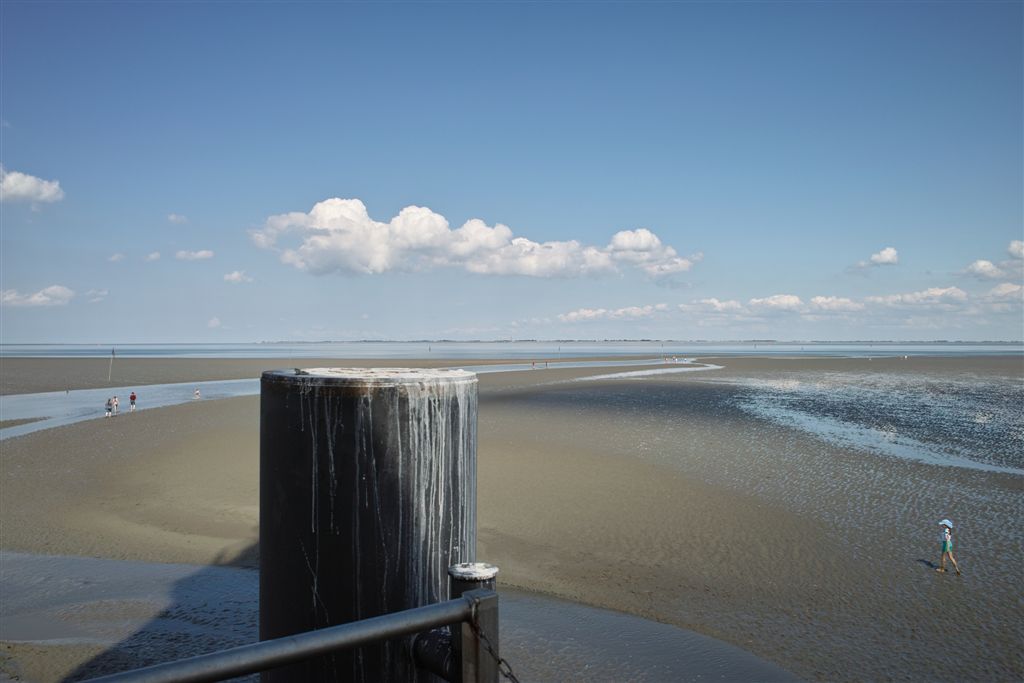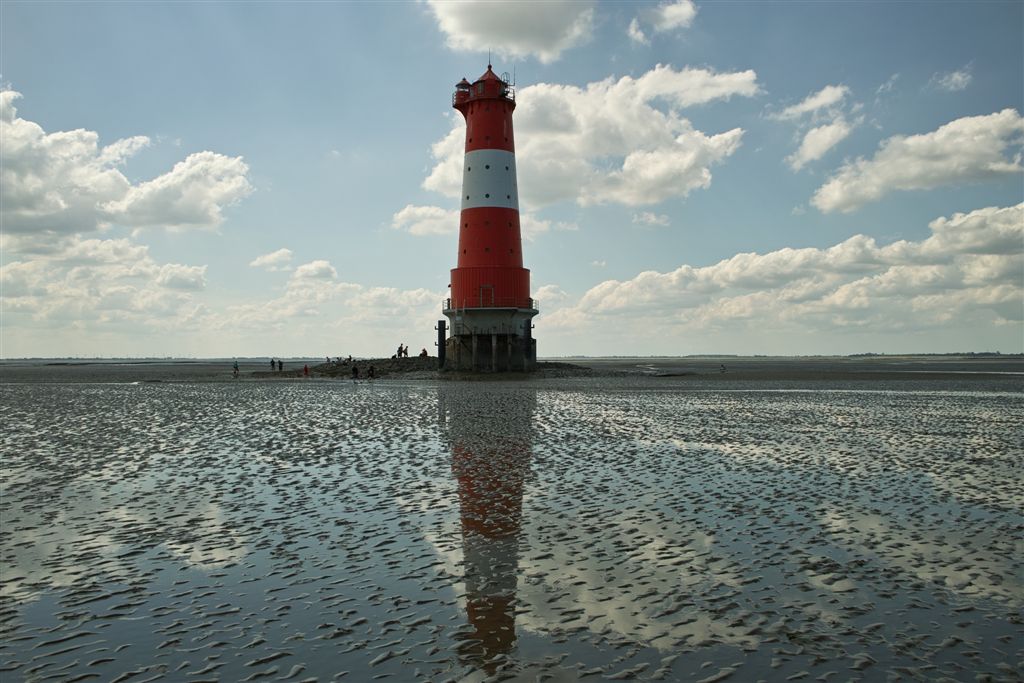
Arngast – eine verschwundene Insel
Ort
Dieser Multi-Earthcache führt zum Leuchtturm Arngast. Er ist auf den Resten einer Insel erbaut.
Erdgeschichtliche Betrachtung
(Earthcache Classification: Coastal Feature)
Wasser hat schon immer wesentlichen und vielfältigen Einfluß auf die Erde und ihre Lebewesen. Es sorgt für Leben (und Tod), transportiert Nährstoffe, gibt Nahrung, formt die Erdoberfläche, u.s.w. Die Küsten sind vom Einfluß des Wassers besonders betroffen.
Sowohl sich langfristig verändernde Wasserstände der Meere als auch plötzliche Fluten sorgten immer wieder für Veränderungen der Küstenlinie. Erst in letzter Zeit (erdgeschichtlich nicht mal ein „Wimpernschlag“) versucht der Mensch u.a. durch Deiche, den Einfluß des Wassers zu beherrschen. Der größte Teil des heutigen Jadebusens war ursprünglich Hochmoor. Er gehört zu den Buchten, die im Mittelalter durch Sturmfluten einbrachen. Entstanden ist er durch die Julianenflut von 1164, die Clemensflut von 1334 sowie die verheerenden Marcellusflut (grote Manndränke) von 1362. 12 kleine Dörfer fielen den Sturmfluten zum Opfer und Butjadingen wurde teilweise zur Insel. Durch die Sturmfluten von 1509 sowie 1511 nahm der Jadebusen noch größere Ausmaße an. Sein Flaschenformumriss läßt die Kraft des Meeres deutlich erkennen. Der nördliche Teil, wo das Meer in junges Groden- oder Polderland eingedrungen war, ist schmal und tief. Besonders viel Landfläche ging landeinwärts in niedrig gelegenen Sietlandgebieten verloren. Das Wasser bahnte sich den Weg bis zum Geestrand wie z. B. Dangast vor. Erst durch haltbare Eindeichungen wurden weitere Veränderungen verhindert.
Auf der Wanderung zu den Resten der Insel Arngast kann man noch jahrhundertealte Zeitzeugen im Watt finden, konservierte Baumwurzeln. Die Wanderung startet auf Land, das einmal Meer war und führt ins Meer, das einmal Land war.
Strecke
WP1 bezeichnet den Campingplatz, der bei der Anfahrt rechterhand einen großen kostenlosen Parkplatz bietet. Dann geht es rd. 3 km auf dem Deich zu WP2. Hier führt ein 700 m langer Weg durch die Salzwiesen ans Watt (WP3). Nun ist das Ziel ncht mehr zu übersehen ;-). An WP4 findet man interessanten Untergrund und an WP5 einen Zeitzeugen aus vergangenen Jahrhunderten. Nach rd. 9 km Wanderung ist das Ziel erreicht (WP6)! Nun geht es 9 Kilometer zurück ;-)
Besonderer Hinweis
Der Weg zum Leuchtturm ist frei zugänglich und ohne Genehmigung jederzeit benutzbar. Die Regeln des Nationalparks Wattenmeer sind hier nachzulesen und zu beachten: https://www.nationalpark-wattenmeer.de/nds/. Die Strecke ist anstrengend und lang. Sie führt durch schwer zu bewältigendes Watt. Als wir unterwegs waren, kehrten 8 Teilnehmer nach 10 Metern Wattwaten wieder um – sie kamen nur auf allen vieren voran. Deshalb ist die Teilnahme an einer Wattführung dringendst anzuraten! Dann ist stets Hilfe nahe, auch wenn die Flut zu früh einsetzt, Nebel oder Sturm aufzieht. Unter https://www.nationalpark-partner-wattenmeer-nds.de/partner/wattfuhrungen-dangast sind zugelassene Wattführer empfohlen. Deren Rat bezüglich Kleidung (Schuhe!!!), Ausrüstung und Kondition sollte unbedingt beherzigt werden.
Logbedingung
1. Fotografiere Dich bzw. Dein GPS am WP5 mit dem Baumstumpf und an WP6 mit dem Leuchtturm und lade sie zu Deinem Log hoch (ab 01.01.11 optional, aber natürlich vom Owner und den Beobachtern gern gesehen).
2. Wieviele Ecken hat das Schild an WP3?
3. Wenn Du an WP4 die Oberfläche beiseite schiebst, was findest Du darunter?
4. Als der Jadebusen entstand, soll eine sagenumwobene Burg versunken sein. Wann war das und wie hieß die Burg? (Internetrecherche)
5. Die Leuchtturmtür hat eine Art “Lenkrad“ als Türverschluß. Wieviele Löcher sind in den Speichen?
6. Auf dem Foto "Entwicklung" siehst Du verschiedene Ausdehnungen des Jadebusens. Recherchiere einen Ort, der durch die Entwicklung des Jadebusens verschwand und datiere es.(Internetrecherche)
Maile die Antworten an Keitaro64{at]web.de.

Arngast - a lost island
Place
This multi earthcache leads to the lighthouse Arngast. It is built on the remains of an island.
Geological speculation
(earthcache classification: coastal feature)
Water has always been essential influence upon the Earth and its creatures. It provides for life (and death), transports nutrients, gives food, shapes the Earth's surface, etc. The coasts are particularly affected by the influence of water. Both long-term changing water levels of the seas and sudden floods were constantly changing the shoreline. Only lately, man tries to control the influence of water by dikes. Originally the largest portion of today's Jadebusen was moor. He is one of the bays, which broke in through storm floods in the Middle age. He arose from the Julianenflut of 1164, the Clemensflut of 1334 as well as of the devastating Marcellusflut (grote Manndränke) of 1362. 12 little villages fell victim to the storm floods and Butjadingen became partially an island. By the storm tides of 1509 as well as 1511 the Jadebusen became even bigger. Through his bottle-shaped outlines, you can clearly see the strength of the sea. The northern part where the sea had entered in young Groden- or Polderland was narrow and deep. Much land area was lost inland in lowly situated Marshes. The water forced the way up to the border of the Geest for e.g. Dangast. Only through solid diking further changes were avoided. On the hiking tour to the remains of the island Arngast preserved tree roots can be found. The walk starts on land that once was sea and leads into the sea, which once was land.
Route
WP1 referred to the camping site, which offers a large free car park on the right side. It is approx. 3 km on the dike to WP2. A 700 m long path through the salt meadows to the tideland (WP3) follows. At WP4 you will find interesting underground and at WP5 a contemporary witnesses from past centuries. After about 9 km hike the goal is reached (WP6)! It is now 9 km back;-)
Special note
The way to the Lighthouse is accessible and usable without permission at any time. Please read the rules of the National Park here: https://www.nationalpark-wattenmeer.de/nds/. The route is hard and long. As we were travelling, 8 participants returned to go back after 10 meters walking in the ”Watt”. Therefore a Nationalpark-Ranger is strongly recommended . https://www.nationalpark-partner-wattenmeer-nds.de/partner/wattfuhrungen-dangast ! Then help is always near, also when the flood comes too early, fog or storm raises. The advice regarding clothing, equipment and condition should necessarily be heeded.
Log condition
1. Make a photo of you or your GPS with the lighthouse at WP5 with the tree stump and WP6.
2. How many corners has the sign on WP3?
3. If you move the surface at WP4 aside, what did you find below?
4. When the Jadebusen came into existance, a legendary Castle shall have sunk. When was that and what is the name of the Castle? (Internet research)
5. The lighthouse door has a sort of "Wheel" as a door lock. How many holes are in the spokes?
6. The photo "Entwicklung" shows different levels of Jadebusens. Mention a town to me, which disappeared through the development of the Jadebusen. When did this happen? (Internet research)
Please send the answers to Keitaro64[at]web.de.
Sources:
Wikipedia
Wattführer
Nationalparkverwaltung
Wadden Sea National Park